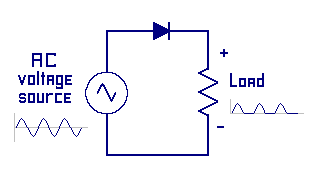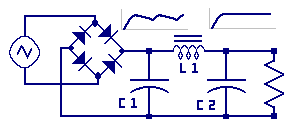
Introduction
Chapter 1 - Electricity
Chapter 2 – Sharing and Bonding
Chapter 3 - Voltage
Chapter 4 - Resistance
Chapter 5 - Semiconductor
Chapter 6 – AC and Hertz
Chapter 7 - Magnetism
Chapter 7.2 - Inductors
Chapter 8 - Capacitor
Chapter 9 - IC's and OP-AMP's
Chapter 9.2 - Feedback, Unity Gain
Chapter 9.3 - Non-inverting Amplifier
Chapter 9.4 - Inverting Amplifier
Chapter 10 - 555 Timer
Chapter 10.2 - 555 Timer- Part 2
Chapter 11 - Logic
Chapter 12 - The Power Supply
Chapter 12.2 - More on Power Supplies
|
|
 Look at this circuit. We are bringing many components together to build this power
supply. Starting on the left side we see the symbol for an alternating current
source. Remember that this is a general symbol representing an AC voltage from any
source. These, might include power from a wall outlet, wind generator, from the secondary coil of
a transformer, or from test equipment called a signal generator.
Look at this circuit. We are bringing many components together to build this power
supply. Starting on the left side we see the symbol for an alternating current
source. Remember that this is a general symbol representing an AC voltage from any
source. These, might include power from a wall outlet, wind generator, from the secondary coil of
a transformer, or from test equipment called a signal generator.